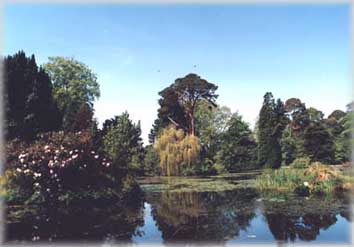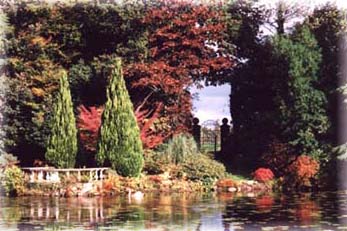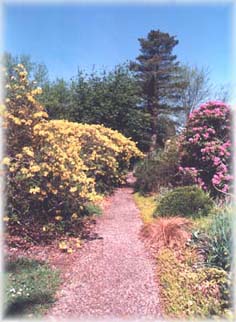![]()
A Short Description of Altamont Garden
FROM the moment one enters the Georgian gates of Altamont, home of Mrs. North, one is struck by the very personal marks imprinted on this well loved and cared for garden, laid out, restored, and developed by generations of owner gardeners.
IN THE Spring a river of Daffodils greets the eye and the two hundred year old Beech Trees lining the avenue, underplanted with a collection of rare Sorbus, dominate the scene. The mellow colouring of the house sets off the venerable Wisterias clambering over its walls. Magnolias and a thirty foot Rhododendron augustinii frame it.
FROM the car park one enters the gardens through antique iron gates beside the Craft Shop, into a courtyard full of choice plants. The local granite stone of the Belfry and Granary here set off the colours of the Roses and Clematis. The Tea-room is opposite; here homemade teas are served on Sunday afternoons. The entrance to the Art Gallery is via the Tea-room.

A view across the lake
A SMALL gate leads through the Swan House to the 'Nun's Walk', which looks like a green cloister with its ancient Beeches. In the Spring this walk is carpeted with small wild Daffodils and Primroses; in the Autumn with Cyclamen and Ferns. The scarlet berries of a group of Skimmias catch the eye at the entrance to the Garden Centre, which is in the walled garden on your right. Here are stocked many of the rarer plants and shrubs which you will meet on your walk through the gardens.
HALF way down the Nun's Walk you turn left, passing under a spreading Parrotia towards the House and Goldfish pool. The formally laid out beds on your left contain an interesting collection of Dwarf Conifers and Shrubs, underplanted with Heathers and bulbs and bordered with Box hedging. The raised beds beside the path are full of treasures for the interested gardener and full of colour and scent for the passer by.
FROM here wide lawns sweep down to the lake with a central walk (the Broad Walk) bordered by 150 year-old Box and clipped Irish Yews which stand like sentinels guarding the route. These Yews were planted in 1852 by the Dawson-Boror's who had the lake dug out by hand to give employment after the Famine. The walk is bordered by beds of roses, mostly Old Fashioned and New English Shrubs and Floribundas, underplanted with 40 different varieties of Snowdrops, Daffodils and Tulips for Spring colour, with Lilies, Violas, Dictamnus and Colchiums adding colour later in the year. "Deodar Cedar and many Stemmed Thuja stand in the lawns near the Dovecote and the Autumn border.

Looking across the lake towards the Myshall Gate
HERE the Octagonal Pool is full of choice mini plants and one of the finest Fern Leaf Beeches can be seen to the left of the Old Goldfish Pool. Beyond a huge Ilex Tree a group of Sorbus, including "Mitchelli" with its big leaves and a Variegated Tulip Tree have recently been planted. A venerable Ukon Cherry dominates this scene. This area is better seen from the "Dark Walk" on your return journey.
PAST the Sundial many moisture loving plants are planted by the Lake's edge and there is a good collection of Hostas. In this area two nice specimens of the Swamp Cyprus can be admired, also a Weeping Silver Birch, a Dawn Redwood and a Kilmacurragh Cyprus, which were planted fifty years ago, as was the Handkerchief Tree and the Tulip Tree close by.
A BORDER of Peonies, Old Roses and Lilies leads to the "Azalea Walk". Several Summer Houses and seats encourage one to pause and enjoy the peace and tranquillity, which are the essence of Altamont Gardens, a boon for tired feet and good places from which to watch the wild birds, butterflies and dragonflies. Over the Iron Bridge the path is bordered by many Rhododendrons and ancient trees. One can take a short detour here over the New Stone Bridge, completed in May 1997. Continuing along the lake to the Promontory and the Myshall Gate, one can find a fine young Hemlock Spruce and a lovely Cornus Kousa from China nearby.

The Azalea Walk
AT THE outlet to the lake, where the statue of a small boy sits and contemplates the water, turn down right and follow the stream to the New Arboretum, where many trees from the Old and New World are planted, including three different species of Southern Beeches, Chilean Fire Trees, various Birches and lots of giant Gunneras etc.
CROSS the stream and make your way to the Lower Glen via the Bog Garden. Huge moss covered rocks left by the melting ice 10,000 years ago and ancient fern draped Oaks, carpets of Bluebells, wild Daffodils and Ferns bordering the burbling stream makes this Glen a place of pure magic at any time of the year. Follow the stream onto the Waterfall and down to the beautiful River Slaney.
IF YOU turn right at the river and go down stream you can climb up the shallow 100 stone steps, with its thoughtfully provided seats, back through the woods and across the "Sunset Field". Here you should note the Golden Oak and the Wellingtonia which was planted to commemorate the Battle of Waterloo, and the magnificent views of the Wicklow and Blackstairs Mountains. Continue on and you will join the Lake Walk at the bridge. Crossing the bridge one gets a better view of the outlines of the lake with its islands and the beautiful reflections of the tree-lined verges beyond. This is a rather long and fairly strenuous walk with rough going in places, but well worth the effort.
![]()
![]() Information
Information ![]() Description
Description
![]() History
History ![]() Students
Students
![]() Herbs
Herbs
![]() Plant Collection
Plant Collection ![]()
![]()